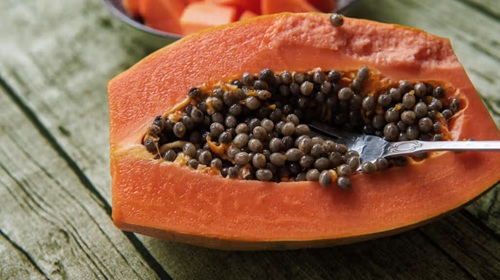Papaya is one of the most widely grown fruits in India due to its nutritional value and medicinal uses. From boosting digestion to improving immunity, it is part of many Indian households. However, when it comes to cultivation, one of the most common questions farmers and gardeners ask is: How to identify male and female papaya seeds?
This confusion arises because papaya trees are dioecious (separate male and female plants) and sometimes hermaphroditic (both functions in one). For fruit production, female or hermaphrodite plants are essential, while male plants only produce pollen and no fruit. Identifying the seed type at an early stage can save time and effort for growers.

Why the Difference Matters
- Male papaya plants: Produce only pollen, no fruits.
- Female papaya plants: Produce fruits, but only if pollinated by a male or hermaphrodite.
- Hermaphrodite papaya plants: Produce fruits on their own and are most preferred for commercial farming.
If a farmer unknowingly plants more male papaya seeds, fruit yield will be extremely low. Hence, identifying seed type before sowing is considered valuable knowledge.
Physical Differences in Papaya Seeds
Although there is no 100% foolproof scientific method to differentiate male and female papaya seeds just by looking at them, traditional Indian farmers have long observed certain differences:
1. Shape of the Seed
- Male Papaya Seeds: Often said to be longer, thinner, or oval-shaped.
- Female Papaya Seeds: Usually rounder, plumper, and fuller in shape.
👉 Farmers believe that a fuller seed is more likely to develop into a fruit-bearing tree.
2. Surface Texture
- Male Seeds: Slightly rougher or less glossy compared to others.
- Female Seeds: Appear smoother and shinier.
3. Size of the Seed
- Male Seeds: Comparatively smaller and lighter.
- Female Seeds: Bigger and heavier, carrying more stored energy to develop into fruit-bearing trees.
Traditional Indian Methods of Identification
Apart from physical differences, farmers also use local techniques to predict the gender of papaya seeds:
1. Water Test
- Place papaya seeds in water.
- Male Seeds: Float more often because they are lighter.
- Female Seeds: Sink to the bottom, indicating better germination and fruit-bearing potential.
👉 While not scientifically proven, many farmers swear by this test.
2. Ash or Soil Germination Method
Farmers sometimes plant seeds in small groups:
- If the plant grows quickly but looks weaker, it is often male.
- Plants that are slightly slower but sturdier are considered female or hermaphrodite.
Scientific Reality
It is important to note that sex differentiation in papaya is genetic, and true identification usually happens only after the plant begins flowering:
- Male Papaya Plant: Produces clusters of small flowers on long stalks.
- Female Papaya Plant: Produces larger flowers, closer to the stem.
- Hermaphrodite Plant: Produces bisexual flowers that contain both stamens and pistils.
Therefore, while seed appearance can provide hints, accurate identification happens only when plants mature and bloom.
Why Farmers Prefer Hermaphrodite Seeds
In modern papaya farming, hybrid varieties are developed that are mostly hermaphroditic. These ensure self-pollination and high fruit yield. Farmers often buy certified hybrid papaya seeds from nurseries to avoid the male vs. female seed problem altogether.
Conclusion
Identifying male and female papaya seeds is a blend of traditional wisdom and observation. Farmers generally differentiate based on shape, size, and weight of the seeds, with female seeds being rounder, larger, and heavier. Tests like the water method are also used in villages. However, the most reliable identification still happens when the papaya plant flowers.
For commercial success, it is always advisable to use hybrid or hermaphrodite papaya seeds from trusted sources. This minimizes the risk of ending up with too many non-fruit-bearing male plants.
In short, while traditional methods can guide you in identifying papaya seeds, science reminds us that nature often reveals its secrets only with time.